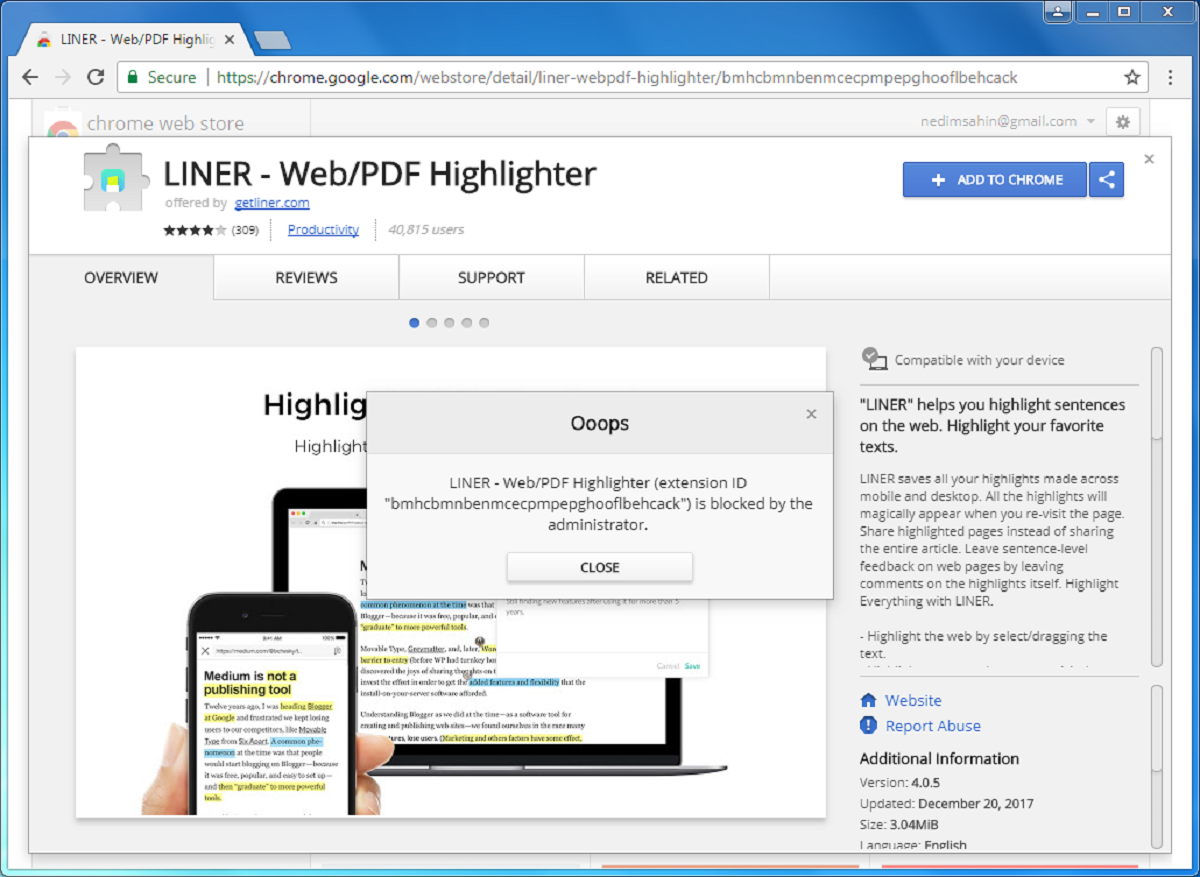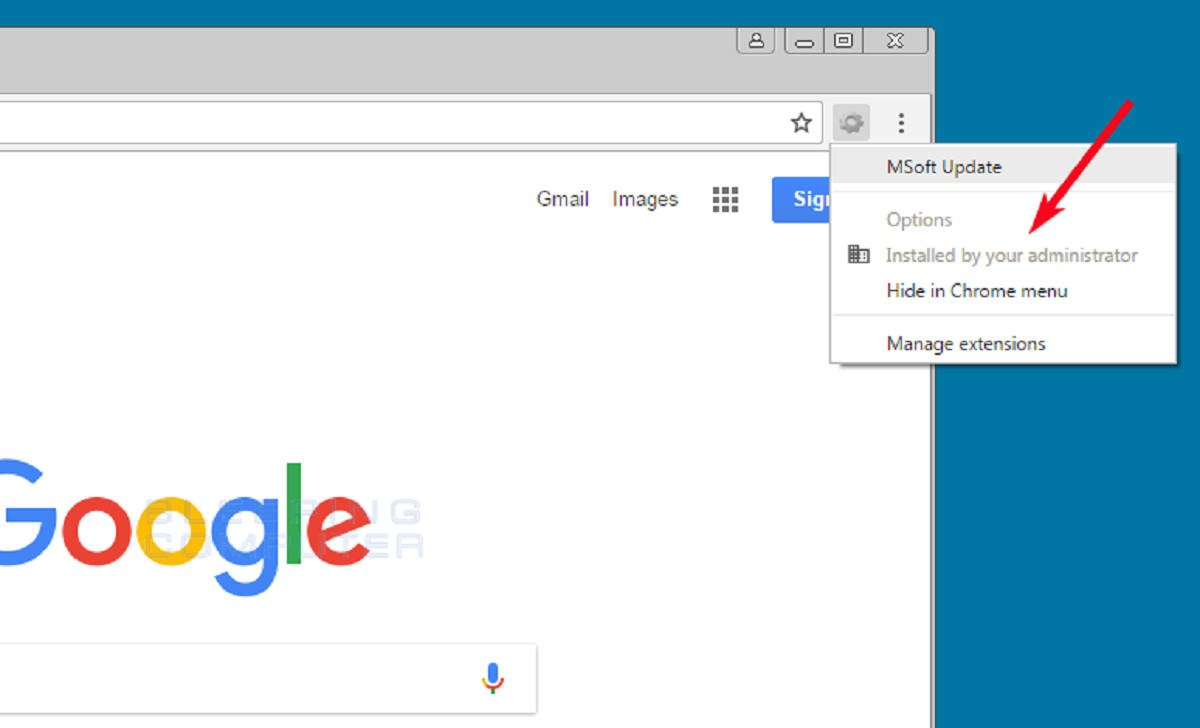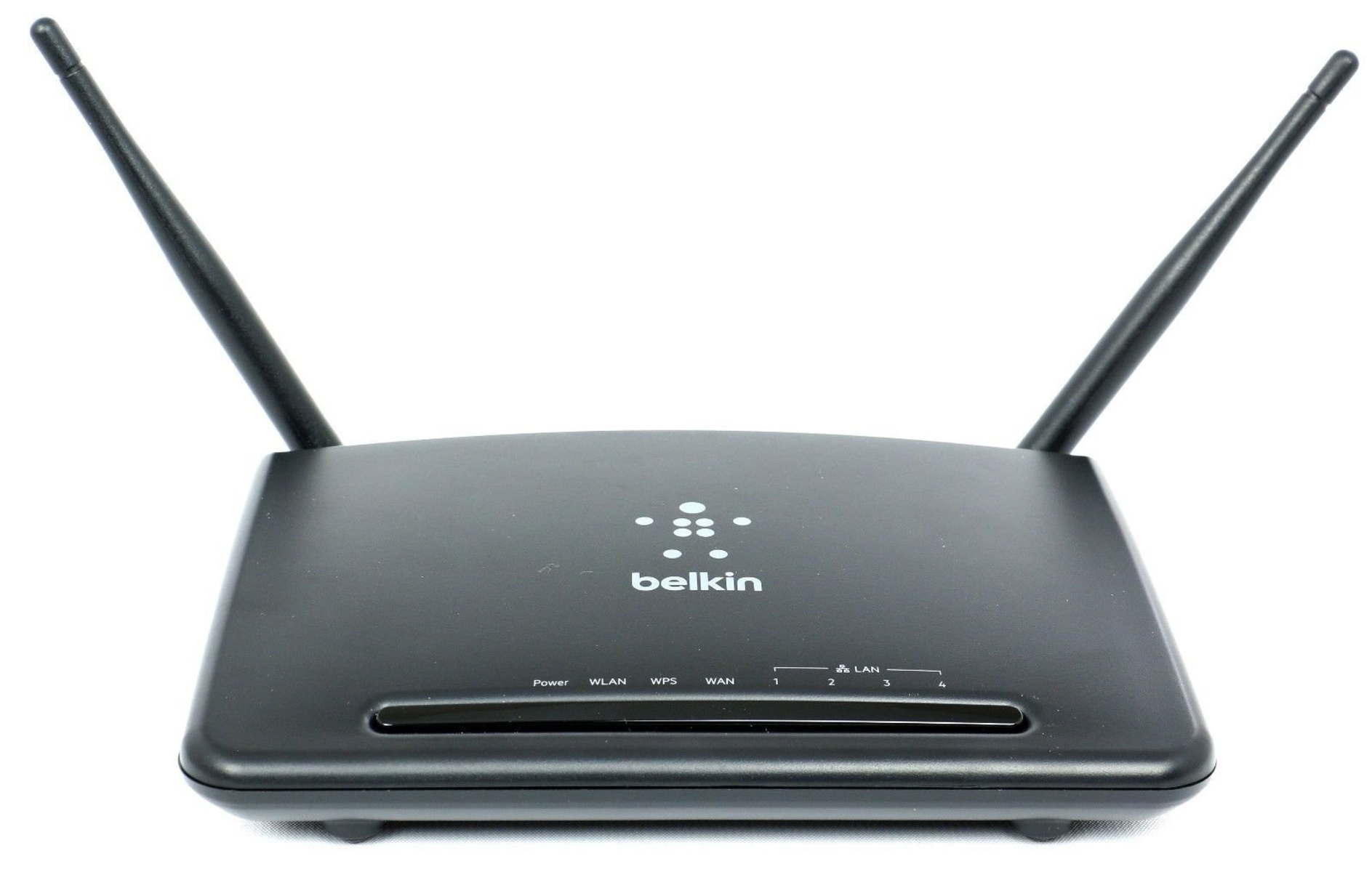Introduction
Chrome extensions are small software programs that add functionality to the Google Chrome browser. They can customize the browsing experience, streamline tasks, and enhance productivity. However, there may be instances where these extensions are blocked by an admin or IT department, preventing users from accessing and utilizing them.
Being unable to use certain Chrome extensions can be frustrating, especially if they are essential for your workflow or personal preferences. Understanding why these extensions are blocked and finding a way to overcome the block is crucial for users who rely on specific features or functionalities provided by these extensions.
In this article, we will delve deeper into the world of Chrome extensions. We will explain why extensions may be blocked by admin, how to check if an extension is blocked, and most importantly, how to overcome the block and regain access to the extensions you need.
Whether you are encountering this issue in a corporate setting or on your personal computer, the information provided here will equip you with the knowledge and tools necessary to navigate around the restrictions and continue enjoying the benefits of Chrome extensions.
Understanding Chrome Extensions
Before we dive into the reasons why Chrome extensions may be blocked by an admin, let’s first establish a clear understanding of what Chrome extensions are.
Chrome extensions are software programs that extend the functionality of the Google Chrome web browser. They are designed to enhance and personalize the browsing experience by adding additional features and capabilities to the browser.
These extensions can do a wide range of things, from adding new functionality to specific websites to providing tools for productivity, security, and entertainment. Some popular examples include ad blockers, password managers, language translators, and note-taking tools.
Chrome extensions are usually built using web technologies such as HTML, CSS, and JavaScript. They are distributed through the Chrome Web Store, where users can browse and download extensions to customize their browsing experience.
Once installed, Chrome extensions appear as icons in the browser’s toolbar or menu. Users can interact with these icons to access the extension’s features and settings. Depending on the functionality provided by the extension, it may require permissions to access certain websites or information on the user’s device.
It is important to note that while Chrome extensions offer valuable features and enhance productivity, they can also pose risks if used irresponsibly or if they come from untrustworthy sources. Users should exercise caution when installing new extensions and ensure they come from reputable developers.
Now that we have a better understanding of what Chrome extensions are, let’s explore the reasons why they may be blocked by an admin or IT department.
Why Chrome Extensions May Be Blocked By Admin
There are several reasons why Chrome extensions may be blocked by an admin or IT department. These restrictions are typically put in place to ensure the security, productivity, and compliance of the organization’s network and devices. Here are some common reasons why extensions may be blocked:
- Security Concerns: Some Chrome extensions may have vulnerabilities or malicious code that can compromise the security of the network or the user’s device. Admins may block certain extensions to prevent any potential security breaches or data leaks.
- Productivity Management: In a corporate environment, admins may block certain extensions to prevent employees from accessing non-work-related websites or applications. This helps maintain productivity and prevents distractions during working hours.
- Compliance Requirements: Certain industries, such as healthcare and finance, have strict compliance requirements regarding data privacy and security. Admins may block extensions that could potentially violate these regulations to ensure the organization remains compliant with industry standards.
- Bandwidth Optimization: Some extensions can consume a significant amount of network bandwidth, especially those that constantly update or sync data in the background. Admins may block these extensions to optimize network performance and ensure smooth operations for all users.
- Compatibility Issues: In some cases, admins may block certain Chrome extensions due to compatibility issues with specific software or systems used in the organization. This prevents any potential conflicts or interruptions in workflow.
It is important to remember that the decision to block Chrome extensions is made by the admin or IT department with the best interest of the organization in mind. These restrictions are meant to ensure the overall security, productivity, and compliance of the network and its users.
Now that we understand why Chrome extensions may be blocked, let’s explore how to check if an extension is blocked by an admin.
How To Check If Chrome Extensions Are Blocked By Admin
If you suspect that a Chrome extension is blocked by an admin or IT department, there are a few steps you can take to check whether this is the case. Here’s how to determine if a Chrome extension is blocked:
- Check Chrome Extension Settings: Start by opening the Chrome browser and navigating to the Chrome Extension settings. You can access this by clicking on the three-dot menu in the top-right corner of the browser and selecting “More tools” and then “Extensions”. Here, you will see a list of all installed extensions. If an extension is blocked, you may see a notification or a message indicating the block.
- Contact Your Administrator: If you are unable to find any information in the Chrome Extension settings, reach out to your administrator or IT department. They will be able to provide you with clarification on whether the extension is blocked and the reasons behind the block. They may also have specific instructions or alternative solutions to help you with your needs.
- Network Access Restrictions: In some cases, when an extension is blocked by an admin, it may be due to network access restrictions. This means that the extension may work on devices outside of the organization’s network or on a different internet connection. If you have access to an external network, try using the extension there to see if it works. If it does, this indicates that the extension is indeed blocked within the organization’s network.
- Monitor the Extension Store: Admins can also block the installation of specific extensions from the Chrome Web Store. You can check the store by navigating to the Chrome Web Store website and searching for the extension in question. If you are unable to find or install the extension, it may be blocked by the admin.
By following these steps, you can get a better understanding of whether an extension is blocked by an admin. This information will help you determine the next course of action to regain access to the blocked extension or explore alternative solutions.
Next, we will explore various methods to overcome Chrome extensions that are blocked by an admin.
Overcoming Chrome Extensions Blocked By Admin
If you find that a Chrome extension is blocked by an admin or IT department, there are several methods you can try to regain access and overcome the block. Here are four methods to consider:
Method 1: Modify Chrome Extension Restrictions: In some cases, the admin may have applied strict restrictions on certain extensions. If you have administrative access to your account or device, you can try modifying these restrictions to allow the installation or use of the blocked extension. However, please note that this method may not always be feasible or recommended, as it could violate the organization’s policies.
Method 2: Use Portable Versions of Blocked Extensions: Some extensions offer portable versions that can be installed manually without going through the Chrome Web Store. These versions are typically in the form of CRX files. By downloading the CRX file directly from a trusted source and dragging it into the Chrome Extensions settings page, you may be able to bypass the block and install the extension.
Method 3: Create a Chrome App to Replace Blocked Extensions: If the functionality provided by the blocked extension is crucial to your workflow, you can try creating a custom Chrome app to replicate its features. Chrome apps can be developed using web technologies and can serve as a workaround when certain extensions are blocked. This method requires some programming knowledge or assistance from a developer.
Method 4: Request Admin to Unblock Chrome Extensions: If none of the above methods work or are not viable options, you can reach out to your administrator or IT department and request them to unblock the specific Chrome extension. Explain the importance of the extension for your work and discuss any alternative solutions or compromises that may address their concerns while allowing you to utilize the extension.
It is important to approach these methods with consideration for the administration’s policies and guidelines. Ensure that any actions taken to overcome the block align with the organization’s security protocols and do not compromise the integrity of the network or violate any compliance requirements.
By exploring these methods and finding a solution that works in your specific scenario, you can overcome Chrome extensions that are blocked by an admin and continue to benefit from their functionalities.
Next, we will dive deeper into each of these methods and provide step-by-step instructions on how to implement them.
Method 1: Modify Chrome Extension Restrictions
If you have administrative access to your account or device, you may be able to modify the Chrome extension restrictions imposed by the admin. By adjusting these settings, you can potentially allow the installation or use of the blocked extension. However, please note that modifying these restrictions may not always be possible or recommended, as it could violate the organization’s policies. Proceed with caution and ensure that you have the necessary permissions before attempting this method. Here’s how you can modify Chrome extension restrictions:
- Open Chrome Extension Settings: Launch the Chrome browser and click on the three-dot menu in the top-right corner. From the dropdown menu, select “More tools” and then “Extensions.”
- Identify the Blocked Extension: Scroll through the list of installed extensions and locate the blocked extension that you want to modify the restrictions for.
- Toggle Developer Mode: At the top-right corner of the Extensions page, you will find a toggle switch labeled “Developer mode.” Enable this mode by sliding the switch to the right.
- Modify Extension Permissions: Once you have enabled Developer mode, you will see additional options for each extension. Click on the “Details” button or the “More options” button (three dots) next to the blocked extension.
- Adjust Extension Restrictions: In the settings page of the extension, you may find various options and permissions that can be modified. Review these settings to see if there are any restrictions that can be adjusted or disabled to allow the extension to function as intended.
- Save Changes: After making the necessary adjustments to the extension’s settings, click on the “Save” or “Apply” button to save the changes.
It is important to note that modifying Chrome extension restrictions may not always result in successfully bypassing the block. The admin may have implemented additional security measures or policies that prevent you from altering these settings. In such cases, consider exploring alternative methods or discussing the issue with your administrator.
Remember to proceed with caution and follow the organization’s guidelines and policies while attempting to modify extension restrictions. Your aim should be to find a compromise that maintains the integrity and security of the network while allowing you to utilize the blocked extension.
Next, we will explore the second method to overcome Chrome extensions that are blocked by an admin: using portable versions of blocked extensions.
Method 2: Use Portable Versions of Blocked Extensions
If you are unable to install a blocked Chrome extension through the Chrome Web Store, an alternative method is to use portable versions of the extension. Portable versions are standalone files that can be manually installed without going through the Chrome Web Store. Here’s how you can use portable versions of blocked extensions:
- Search for the Portable Version: Start by searching for the portable version of the blocked extension. You can look for trusted sources online that provide CRX files of Chrome extensions. Ensure that you download the portable version from a reputable source to avoid any malware or security risks.
- Download the CRX File: Once you have found the portable version of the extension, download the CRX file to your computer. Make sure to save it in a location where you can easily access it later.
- Open Chrome Extension Settings: Launch the Chrome browser and click on the three-dot menu in the top-right corner. From the dropdown menu, select “More tools” and then “Extensions.”
- Enable Developer Mode: At the top-right corner of the Extensions page, enable Developer mode by toggling the switch to the right.
- Drag and Drop the CRX File: With Developer mode enabled, locate the CRX file you downloaded earlier and drag it into the Extensions page. You will see a prompt asking if you want to install the extension. Click “Add extension” to proceed.
- Confirm Installation: After clicking “Add extension,” the portable version of the blocked extension will be installed in Chrome. You may need to adjust any necessary settings or permissions within the extension itself.
By using portable versions of blocked extensions, you can bypass the restrictions imposed by the admin and still access the functionalities provided by the extension. However, please note that this method should be used with caution. Ensure that you download portable versions from trusted sources and exercise caution to avoid any security risks.
If you are unsure about the legality or policy compliance of using portable versions of blocked extensions within your organization, it is always best to consult your administrator or IT department for guidance.
Next, we will explore another method to overcome Chrome extensions that are blocked by an admin: creating a Chrome App to replace the blocked extensions.
Method 3: Create a Chrome App to Replace Blocked Extensions
If the blocked Chrome extension provides essential functionality that you cannot go without, an alternative method is to create a custom Chrome app to replace the blocked extension. Chrome apps can be developed using web technologies and can serve as a workaround when certain extensions are blocked. Here’s how you can create a Chrome app to replace a blocked extension:
- Identify the Extension’s Functionality: Determine the specific features and functionalities provided by the blocked extension. Make a list of the essential functions that you would like to replicate in your custom Chrome app.
- Develop the Chrome App: If you have web development skills, you can create a Chrome app using HTML, CSS, and JavaScript. The app can be designed to mimic the functionality of the blocked extension. If you are not a developer, you can consider hiring a web developer to create the app for you.
- Package the Chrome App: Once the Chrome app is developed, it needs to be packaged as a CRX file, similar to a Chrome extension. This file will be used to install the app onto your Chrome browser.
- Install the Custom Chrome App: To install the custom Chrome app, open the Chrome browser and navigate to the Extensions page. Enable Developer mode and then click on the “Load unpacked” button. Select the folder where you have stored the packaged CRX file of your custom app and click “OK” to install it.
- Test and Adjust: After installing the custom Chrome app, test its functionality to ensure it replicates the essential features of the blocked extension. If necessary, make adjustments to improve the app’s performance or usability.
Creating a custom Chrome app allows you to replace the functionality of a blocked extension. However, it’s important to note that this method requires programming knowledge or assistance from a developer. Additionally, keep in mind that the custom app may not fully replicate all the features of the blocked extension, but it can provide a suitable workaround in many cases.
Before creating a custom Chrome app, check with your organization’s policies and guidelines to ensure that developing and using custom apps is allowed, and that it doesn’t violate any security protocols or compliance requirements.
Next, we will explore Method 4: requesting the admin to unblock the Chrome extension.
Method 4: Request Admin to Unblock Chrome Extensions
If you have exhausted the previous methods and are unable to overcome the block on a specific Chrome extension, you can consider reaching out to your administrator or IT department and request them to unblock the extension. Here’s how you can approach this method:
- Gather Information: Collect relevant information about the blocked extension, including its name, purpose, and how it benefits your work or productivity. If possible, provide examples or case studies that highlight the positive impact of the extension.
- Explain the Situation: Write a clear and concise explanation of why you need the blocked extension and how it enhances your workflow or contributes to your job responsibilities. Emphasize the value it brings and how it can improve productivity or efficiency.
- Suggest Alternatives or Compromises: If the administrator has concerns about security or compliance that led to the blocking of the extension, propose alternative solutions or compromises. This could include using a similar, secure extension or exploring additional security measures to address any potential risks.
- Be Professional and Respectful: Approach the administrator or IT department in a professional and respectful manner. Clearly state your request and provide all the necessary information to support your case. Remember that they are responsible for the network’s security and policy compliance and may have valid reasons for blocking the extension.
- Follow Up: If you don’t receive an immediate response, follow up after a reasonable period of time. Politely inquire about the status of your request and offer any additional information or clarification that may be needed.
By directly communicating with the administrator or IT department, you have the opportunity to explain your specific need for the blocked extension and potentially find a resolution. However, it’s important to understand that their decision will ultimately depend on organizational policies, security considerations, and compliance requirements.
Remember to approach the process with a solutions-oriented mindset and be open to alternative suggestions or compromises that still address your needs while also satisfying the organization’s requirements.
Next, we will recap the key points discussed in this article before concluding.
Conclusion
Dealing with blocked Chrome extensions can be frustrating, especially when they are essential for your workflow or personal preferences. However, by understanding the reasons behind the block and exploring alternative methods, you can overcome these restrictions and regain access to the functionality you need.
In this article, we discussed the various reasons why Chrome extensions may be blocked by an admin, including security concerns, productivity management, compliance requirements, bandwidth optimization, and compatibility issues. Understanding these reasons helps us appreciate the importance of maintaining a secure and productive network environment.
We also explored methods to check if Chrome extensions are blocked, such as reviewing the Chrome Extension settings, contacting the administrator or IT department, and testing on external networks. These steps allow you to gain clarity on whether a specific extension is blocked and seek solutions accordingly.
Additionally, we discussed four methods to overcome blocked Chrome extensions. These methods include modifying Chrome extension restrictions, using portable versions of blocked extensions, creating custom Chrome apps, and requesting the admin to unblock the extension. Each method has its own considerations and limitations, so it’s important to choose the most suitable option based on your situation and organizational policies.
Remember, when attempting to overcome blocked Chrome extensions, always prioritize the security, productivity, and compliance of your network and devices. Respect the policies set by your organization and work towards finding a compromise that meets both your needs and the goals of the administrator or IT department.
By taking a proactive approach, exploring alternative options, and communicating effectively with your administrator, you can navigate around blocked Chrome extensions and continue to benefit from the features and functionalities you require for an optimized browsing experience.
Remember to stay informed about the latest policies and guidelines regarding extensions within your organization, as these may change over time. With the right strategies and a cooperative approach, you can find solutions that strike a balance between security and productivity.

























